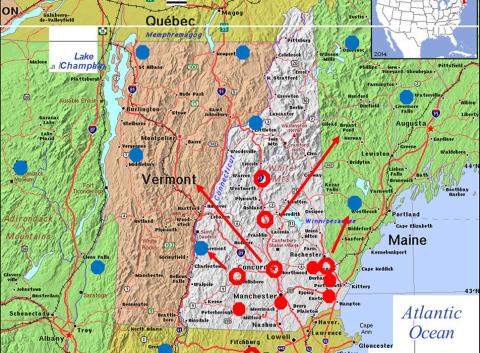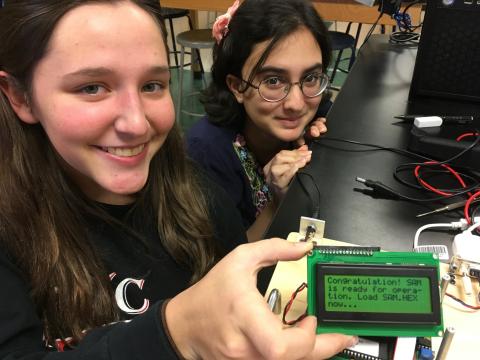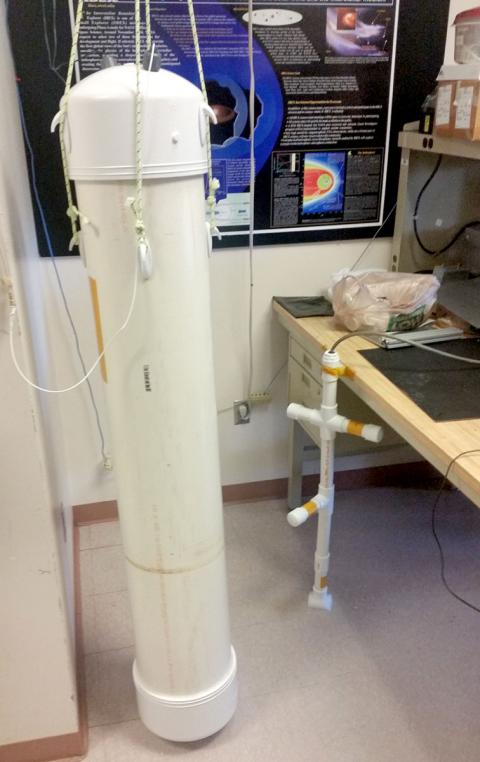Ionospheric currents result from changing magnetic fields that often are the result of either solar transients striking the Earth’s magnetosphere or magnetic reconnection in the magnetotail. Both can result in energetic charged particles striking the Earth’s atmosphere resulting in auroral activity. The ionospheric currents produce changing magnetic fields that can be measured on the Earth’s surface. Gradients in the field are typically measured at distances comparable to or greater than 100 km. The purpose of the SWUG array is to measure these gradients in magnetic activity at mid-latitude locations and associate them with ionospheric currents and global magnetospheric activity.

Measured magnetic field at Exeter (top) and Durham (bottom), N.H., prior to deployment of the instruments. Final alignment of the axes with the global magnetic field of the Earth had not yet been performed.
This figure shows a magnetic transient measured at the same time at both Durham and Exeter, NH from shortly after 2:00 until shortly before 3:00. The two locations are too close to resolve a temporal separation on this scale. The top panel also shows a contamination event from about 1:15 until 1:45 that has been resolved. This plot shows both the potential for performing science at multiple site and the utility of using multiple sites to remove contamination due to human activity.

This image shows the concept for the eventual SWUG magnetometer array. As the array evolves, we will also evolve the placement of nodes within the array. Solid red circles are existing builds. Open red circles are ongoing builds. Solid blue circles are notional.

We are building an array of magnetometers across New England. Although it is not uncommon for arrays such as this to use high-resolution DC and AC instruments at significantly greater cost, there is interesting science that can be performed with simpler and far less expensive instruments such as the SAM-III fluxgate. By containing cost, we can build a larger array with more nodes and involve young people in the construction. This approach provides students with experience building and testing electronics and with exposure to core space physics dynamics.
The SAM-III magnetometer is a robust fluxgate design that can be purchased for $500 from Reeve Electronics. It is easy to build but contains enough circuitry to challenge a first-time high-school builder. It provides magnetic field measurements with 1 nanoTesla (nT) resolution at a 1 sec cadence.


Once built, the magnetometers are mounted within a “tree” made of 1.5-inch PVC plastic that is then lowered into a water-tight tube that is buried vertically in the ground. Deployment of the instrument includes the tree to maintain rectilinear alignment of the sensors, the large water-tight tube used to house the assembled instrument, photovoltaics and battery to provide remote power, GPS for an accurate time tag, and radio to provide automated data downlink.
Data from the SWUG array flows into a data center where it is made available to the public. Both the data and how to use it are described further at the link below.
The array is presently under development. Five nodes are running and should be deployed shortly. Six more nodes are presently under construction and scheduled for deployment soon.
Useful and Relevant Links:
Space Weather UnderGround Main Page
SWUG Data Center
Last modified: December 15, 2022